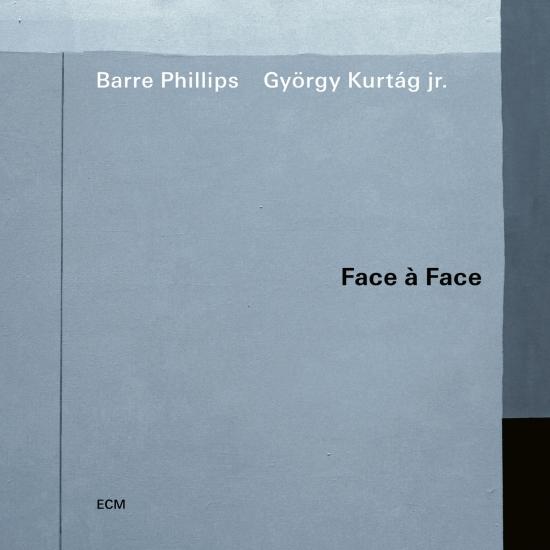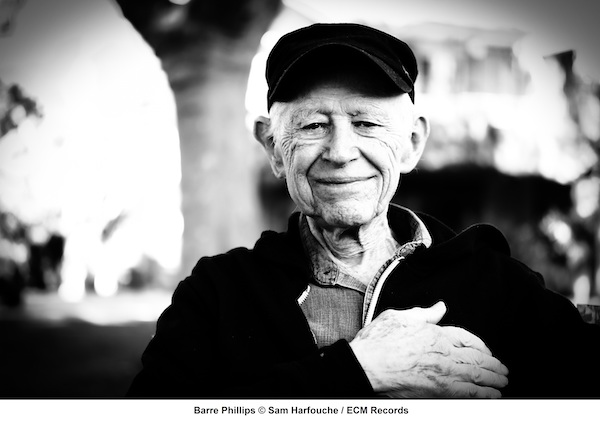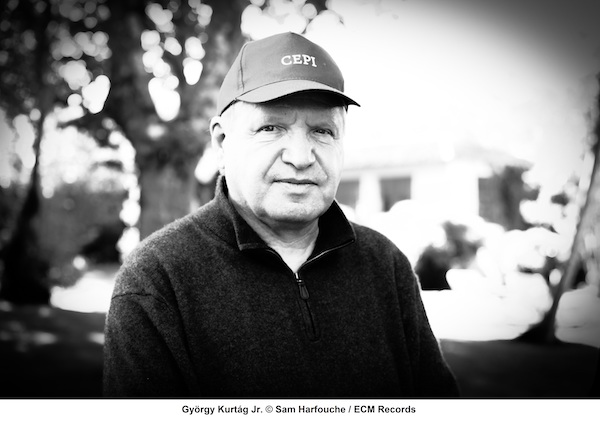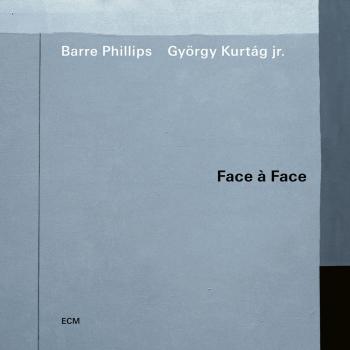
Face à Face Barre Phillips & György Kurtág Jr.
Album Info
Album Veröffentlichung:
2022
HRA-Veröffentlichung:
19.08.2022
Label: ECM Records
Genre: Jazz
Subgenre: Contemporary Jazz
Interpret: Barre Phillips & György Kurtág Jr.
Das Album enthält Albumcover Booklet (PDF)
Entschuldigen Sie bitte!
Sehr geehrter HIGHRESAUDIO Besucher,
leider kann das Album zurzeit aufgrund von Länder- und Lizenzbeschränkungen nicht gekauft werden oder uns liegt der offizielle Veröffentlichungstermin für Ihr Land noch nicht vor. Wir aktualisieren unsere Veröffentlichungstermine ein- bis zweimal die Woche. Bitte schauen Sie ab und zu mal wieder rein.
Wir empfehlen Ihnen das Album auf Ihre Merkliste zu setzen.
Wir bedanken uns für Ihr Verständnis und Ihre Geduld.
Ihr, HIGHRESAUDIO
- 1Beyond01:30
- 2The Under Zone01:53
- 3Two by Two04:12
- 4Across the Aisle04:22
- 5Algobench01:17
- 6Chosen Spindle04:15
- 7Extended Circumstances03:04
- 8Bunch03:10
- 9Sharpen Your Eyes02:10
- 10Ruptured Air03:10
- 11Stand Alone03:17
- 12Forest Shouts01:24
Info zu Face à Face
Der Doyen der improvisierten Musik am Kontrabass und der in der avantgardistischen elektronischen Musik versierte György Kurtág Jr. – Sohn des größten zeitgenössischen ungarischen Komponisten – teilen eine tiefe Leidenschaft, Musik im Moment zu kreieren. Mit seinem subtilen Einsatz von Synthesizern und digitaler Perkussion formt György für Barre Phillips stets changierende Räume – ein akustisches Labyrinth – die in Manfred Eichers detailliertem Mix klar beleuchtet werden. Face à Face, ein durchweg faszinierendes Album, wurde in den Studios La Buissonne in Südfrankreich aufgenommen.
Barre Phillips' Album End to End, das 2018 erschien, brachte die Dokumentation seiner Musik für Solobass zu einem tiefgreifenden Abschluss. Nun legt Face à Face in Improvisationen mit György Kürtág Jr. den Schwerpunkt wieder auf die Zusammenarbeit, den Dialog und das gemeinsame Schaffen.
Der ungarische Komponist und Improvisator, der zuletzt 2009 auf dem Album Kurtágonals bei ECM zu hören war, beschreibt seine musikalische Beziehung zu Barre als "eine der wichtigsten meines Lebens", und auf Face à Face ist sofort zu hören, dass die beiden Musiker ein fortgeschrittenes Verständnis teilen. Es ist ein Verständnis, das sie über die Jahre geduldig aufgebaut haben. Seit 2014 haben sie ihr Duo-Projekt mit Kontrabass, Synthesizern und digitalem Schlagzeug entwickelt, und es ist textlich und dynamisch fesselnd und faszinierend zu verfolgen.
"Das erste Bild, das mir einfällt, um die Art und Weise zu charakterisieren, wie ich mit Barre spiele, ist architektonisch", sagt Kurtág in den Liner Notes des Albums. "Ich habe es mit einem Musiker zu tun, dessen Spiel und Phrasierung sich ständig und auf die unvorhersehbarste Weise verändert. Um mit seiner Musik in Beziehung zu treten, betrachte ich sie als ein sich bewegendes Individuum und baue Räume aus Zeit und Raum um ihn herum. Räume, die sich selbst in ständiger Entwicklung befinden. Ich könnte auch sagen, dass ich einen Schatten erschaffe, den Schatten von Barres Kontrabass, von seinem Spiel... aber es ist ein dynamischer Schatten, in dem ich 'Attraktoren' platziere, das heißt, Hinweise, Richtungen, die befolgt werden oder auch nicht, die aber dazu beitragen, die Intensität des Dialogs zwischen uns aufrechtzuerhalten."
Ihre musikalischen Ursprünge liegen weit auseinander: Der in San Francisco geborene Barre bewegte sich in den 1960er Jahren in den Extremen des New Jazz, von der Band von Archie Shepp über die Jimmy Giuffre 3 bis zum Septett von Chris McGregor, während Kurtág Jr., Sohn des Komponisten György Kurtág und der Pianistin Márta Kurtág, in einem Haus voller Musik in Budapest aufwuchs.
Schon früh in Phillips' Biografie gibt es Hinweise auf sein Interesse an der Elektronik als Quelle für neue Klangfarben. Seine Aufnahme Unaccompanied Barre (1968) sollte ursprünglich Material für die elektronische Transformation durch den Komponisten Max Schubel liefern. Aquarian Rain (1992) war eine Zusammenarbeit mit den elektroakustischen Komponisten James Giroudon und Jean-François Estager, bei der Barres Bass einer Tonbandcollage gegenübergestellt wurde. Und Mountainscapes, Barres Meisterwerk von 1976, enthält einfühlsame Duette mit dem Synthesizer-Spieler Dieter Feichtner, die man als Vorgeschmack auf die Klangwelt von Face à Face betrachten könnte.
Und obwohl Phillips zunächst als Jazzmusiker bekannt wurde, waren seine musikalischen Leidenschaften immer breiter angelegt. "Ich war von Bartók, Schönberg und Strawinsky genauso begeistert wie von Duke Ellington, Charlie Parker und Ornette Coleman", sagt er. "Die beiden Einflüsse waren in meinem Kopf etwa 50/50." Barres lange Zusammenarbeit mit ECM begann 1971 mit dem Duo mit Dave Holland auf Music From Two Basses und umfasste seitdem die Zusammenarbeit mit Terje Rypdal, John Surman, Paul Bley, Evan Parker, Joe Maneri und anderen.
György Kurtág Jr. verließ Ungarn Anfang der 1980er Jahre und ging nach Frankreich, um am IRCAM in Paris zu forschen, wo er die Gelegenheit hatte, mit Peter Eötvös, Mauricio Kagel, Tod Machover, David Wessell, George Lewis und vielen anderen zu arbeiten. In dieser Zeit verlagerten sich seine Interessen allmählich von einer zeitgenössischen Kompositionsperspektive zu einer umfassenderen Sichtweise, die Instrumentenbau und Improvisation einschließt.
Er hat weiterhin an vielen Fronten gearbeitet. Zusammen mit seinem Vater György Kurtag Sr. schuf er die "elektronische Hybrid"-Komposition Zwiegespräche für Streichquartett und Synthesizer, die später mit dem Arditti- und dem Keller-Quartett realisiert wurde.
Das 2009 erschienene ECM New Series Album Kurtágonals rekontextualisiert Stücke, die Kurtág Jr. über einen Zeitraum von 30 Jahren geschrieben hat. Im Jahr 2010 gewann Kurtág Jr.'s Trio Sc.Art (Wissenschaft und Kunst) den Hungarian Classic Contemporary Album of the Year Award für seine Aufnahme The Well-Tempered Universe.
2015 gründete Barre Phillips das Centre Européen Pour l'Improvisation (CEPI) in Puget Ville in der Provence, um kreative Ansätze für das Musikmachen zu erforschen. György Kurtág Jr. stand in diesem Zusammenhang in ständigem Austausch mit Barre, übernahm schließlich die Leitung der Vereinigung und spielte mit dem Bassisten auch in einem großen Ensemble, den Cepi Nomads, das aus den Mitgliedern der Vereinigung besteht.
Auf Face à Face umfasst das elektronische Setup von György Kurtág Jr. Yamaha DX7 IIFD, Korg T3 und Roland JD800 Synthesizer, die durch Roland Handsonic Digital Percussion ergänzt werden, um Klänge zu lokalisieren und zu projizieren, die sich mit Barre Phillips' unendlich kreativem Bassspiel verbinden. Der transparente Mix und die Produktion von Manfred Eicher machen diese Begegnung zu einem Erlebnis, das den Hörer ermutigt, der Musik in all ihren Details zu folgen.
György Kurtág Jr. komponiert und forscht weiterhin in der französischen Region Bordeaux. Anfang 2022 kehrte Barre Phillips nach mehr als 50 Jahren in Frankreich in die Vereinigten Staaten zurück. Derzeit lebt er in New Mexico.
Barre Phillips, Kontrabass
György Kurtág jr., Live Electronics

 Barre Phillips
Barre Phillips
“I play everything based on what my ear suggests I play, with no objective editing. And my ear is fed by a pool of accumulated musical experiences stored in my memory, mental memory and muscle memory. My active role is to do the best I can to play on my instrument what my ear is suggesting.”
Bassist Barre Phillips, who was born in 1934 in California but has lived in the south of France since the early 1970s, has been at the forefront of successive revolutions in improvised music. He initially followed an academic career to the age of 25, until one day, as he puts it, he “just flipped” and decided that he would pursue his passion for music “come hell or high water”.
Ornette Coleman set him on his jazz path around 1960 and he was soon working the extremes of the “New Thing”, playing improvised chamber music with Jimmy Guiffre and freely expressive “fire music” with Archie Shepp. In London in the late 1960s he played with John Stevens’ history-making Spontaneous Music Ensemble and with the South African musicians around Chris McGregor. He then co-founded the powerhouse group The Trio with John Surman and Stu Martin, which appeared on Mountainscapes. Phillips’ first recording for ECM, however, was the 1971 duo album Music for Two Basses with Dave Holland, the first duo for basses issued on any label (“a fine record by two masters of the instrument”, BBC).
After further recordings for the label with Surman, and with Terje Rypdal, and the solo bass album, Call Me When You Get There, Phillips experimented with music for bass, percussion and tape on Aquarium Rain and mediated between Evan Parker and Paul Bley on Time Will Tell and Sankt Gerold, the latter a live album, taped at the Austrian mountain monastery. John Fordham, writing about this album in the Guardian, praised Phillips for “on the one hand swirling, smoky bowed textures and on the other great tension between his precision of pitch and buzzing-bee abstractions”. The bassist also collaborated with Joe and Mat Maneri on two ECM discs, Tales of Rohnlief and Angles of Repose, the second of which was recorded at the ancient chapel of Sainte Philomène, which adjoins Phillips’s home in Puget-Ville.
György Kurtág jr
By the time the Hungarian composer György Kurtág was born in Lugos in 1926, the town was called Lugoj, and had, due to the peace treaty of Versailles, been ceded to Romania. Kurtág grew up in a multi-ethnic environment. It was as natural for him as for his friend György Ligeti, born in 1923 in Tarnaveni not far from Lugos, to speak three languages on a daily basis: Hungarian, Romanian and German.
The first significant pedagogue-personality Kurtág came in touch with was his piano teacher Magda Kardos at Temesvár/Timisoara. Her influence has stayed with him ever since. It was Magda Kardos who entrusted the young man to coach younger pupils – an activity that has kept him busy up to this day.
Kurtág met Ligeti at the entrance examination at the Budapest Academy of Music in 1946 for the first time. They were to form a life-long friendship. Some professors of the Academy gave Kurtág important impulses – such as Ferenc Farkas, who was also Ligeti’s teacher, as well as Leó Weiner, Lajos Bárdos, Pál Járdányi and others.
The next important encounter in Kurtág’s life occurred in Paris where he attended courses by Messiaen and Milhaud in 1957 and 1958. Most important of all, however, were the sessions with the psychologist Marianne Stein who specialised in artists. She tided him over a crisis which had paralysed his creativity for years. Kurtág says the meeting with Marianne Stein divided his life in two – she gave him a new lease of life, so to speak.
On his way back to Budapest Kurtág stopped over in Cologne where he first met Ligeti after the latter’s escape from Hungary in 1956. Ligeti introduced Kurtág to Stockhausen whose Gruppen made a tremendous impact on him. So did Ligeti’s Artikulation, realised in the electronic studio of West-German Radio.
Back in Budapest, Kurtág composed his first string quartet which he denoted as his Opus 1 – to signify that it marked the starting point of his oeuvre proper.
Kurtág is published in Hungary by Editio Musica Budapest. In the years of the cold war, when the world was divided into two on either side of the Iron Curtain, he needed another publisher as well to represent him in the west. Thanks to his friendship with Alfred Schlee, Director of Universal Edition, he signed a contract with UE. The pieces he wrote in those years were not easy to promote: the string quartet was followed by a wind quintet, eight piano pieces, eight duos for violin and cimbalom, The Sayings of Péter Bornemisza, a substantial work for soprano and piano and one of his key compositions, Four Capriccios for soprano and ensemble (his first piece for a larger combination of instruments which included a cimbalom), Four Lieder to poems by János Pilinszky, for baritone, two cimbaloms, a bass zither and some other instruments and In Memory of a Winter Evening for soprano, violin and cimbalom. Truly, works difficult to promote, especially those written for the cimbalom, which in those years had just a couple of players outside Hungary.
Political developments did away with the so-called socialist camp and with the disappearance of the Berlin Wall there disappeared the division of Europe as well. Kurtág no longer needed a publisher in the west and all his compositions have since been entrusted to Editio Musica Budapest. The ones that used to be shared by EMB and UE were duly divided up so that Universal Edition possesses the copyright of a range of pieces for the whole world. They include some of his pivotal early works, such as the Bornemisza-concerto and the Pilinszky Lieder (the only composition for which Kurtág has written programme notes).
Universal Edition is the world-wide distributor of Rückblick. Old and new for four instruments. Hommage à Stockhausen, apart from Hungary. Rückblick could be translated as “Looking Back”, incorporating as it does arrangements of old works, some of the UE, some EMB copyright, as well as some new ones.
It is a kind of ritual taking up a full concert. The composer has yet to make up his mind about its definitive shape – until he does so, the work cannot be printed in its entirety. That is why UE has published Fourteen Fragments from Rückblick, covering the pieces that are originally its copyright. The Fragments have a duration of some 17 minutes and are scored – like the rest of Rückblick – for trumpet, double-bass and keyboard instruments.
Kurtág recently wrote a brief piano trio which he says is one of his best compositions. Varga Bálint ligaturája ("The Ligatura of Bálint Varga") is published by Universal Edition. Hopefully it will be expanded by a second movement.
On 1 December 2013 Kurtág was honoured with the Royal Philharmonic Society Gold Medal at the Queen Elizabeth Hall in London. In 2015, he received the BBVA Foundation “Frontiers of Knowledge Award”.











